Modelling Consumer Demand in Intermittent Water Supply (IWS) Networks: Evidence from Nepal †
Abstract
1. Introduction
2. Materials and Methods
3. Results
4. Discussion
5. Conclusions
- Field measurements have identified a range of withdrawal types practised by households that are not currently reflected in hydraulic IWS models;
- Consumer demand profiles vary between different households and household storage volume appears to be a key determining factor;
- More research is required to understand the variation in withdrawal behaviour between different IWS networks and supply regimes.
Author Contributions
Funding
Institutional Review Board Statement
Informed Consent Statement
Data Availability Statement
Acknowledgments
Conflicts of Interest
References
- Bivins, A.W.; Sumner, T.; Kumpel, E.; Howard, G.; Cumming, O.; Ross, I.; Nelson, K.; Brown, J. Estimating Infection Risks and the Global Burden of Diarrheal Disease Attributable to Intermittent Water Supply Using QMRA. Environ. Sci. Technol. 2017, 51, 7542–7551. [Google Scholar] [CrossRef] [PubMed]
- Speight, V.; Khanal, N.; Savic, D.; Kapelan, Z.; Jonkergouw, P.; Agbodo, M. Guidelines for Developing, Calibrating, and Using Hydraulic Models; Water Research Foundation: Denver, CO, USA, 2010; pp. 42–44. [Google Scholar]
- Kumpel, E.; Woelfle-Erskine, C.; Ray, I.; Nelson, K.L. Measuring household consumption and waste in unmetered, intermittent piped water systems. Water Resour. Res. 2017, 53, 302–315. [Google Scholar] [CrossRef]
- Sarisen, D.; Koukoravas, V.; Farmani, R.; Kapelan, Z.; Memon, F.A. Review of hydraulic modelling approaches for intermittent water supply systems. Aqua Water Infrastruct. Ecosyst. Soc. 2022, 71, 1291–1310. [Google Scholar] [CrossRef]
- Abdelazeem, O.; Meyer, D.D.J. How to Model an Intermittent Water Supply: Comparing Modeling Choices and Their Impact on Inequality. J. Water Resour. Plan. Manag. 2024, 150, 04023071. [Google Scholar] [CrossRef]
- Taylor, D.D.J.; Slocum, A.H.; Whittle, A.J. Demand Satisfaction as a Framework for Understanding Intermittent Water Supply Systems. Water Resour. Res. 2019, 55, 5217–5237. [Google Scholar] [CrossRef]


Disclaimer/Publisher’s Note: The statements, opinions and data contained in all publications are solely those of the individual author(s) and contributor(s) and not of MDPI and/or the editor(s). MDPI and/or the editor(s) disclaim responsibility for any injury to people or property resulting from any ideas, methods, instructions or products referred to in the content. |
© 2024 by the authors. Licensee MDPI, Basel, Switzerland. This article is an open access article distributed under the terms and conditions of the Creative Commons Attribution (CC BY) license (https://creativecommons.org/licenses/by/4.0/).
Share and Cite
MacRorie, M.; Weston, S.; Pudasaini, K.; Price, R.; Speight, V.; Collins, R. Modelling Consumer Demand in Intermittent Water Supply (IWS) Networks: Evidence from Nepal. Eng. Proc. 2024, 69, 38. https://doi.org/10.3390/engproc2024069038
MacRorie M, Weston S, Pudasaini K, Price R, Speight V, Collins R. Modelling Consumer Demand in Intermittent Water Supply (IWS) Networks: Evidence from Nepal. Engineering Proceedings. 2024; 69(1):38. https://doi.org/10.3390/engproc2024069038
Chicago/Turabian StyleMacRorie, Matthew, Sally Weston, Kabindra Pudasaini, Robin Price, Vanessa Speight, and Richard Collins. 2024. "Modelling Consumer Demand in Intermittent Water Supply (IWS) Networks: Evidence from Nepal" Engineering Proceedings 69, no. 1: 38. https://doi.org/10.3390/engproc2024069038
APA StyleMacRorie, M., Weston, S., Pudasaini, K., Price, R., Speight, V., & Collins, R. (2024). Modelling Consumer Demand in Intermittent Water Supply (IWS) Networks: Evidence from Nepal. Engineering Proceedings, 69(1), 38. https://doi.org/10.3390/engproc2024069038






